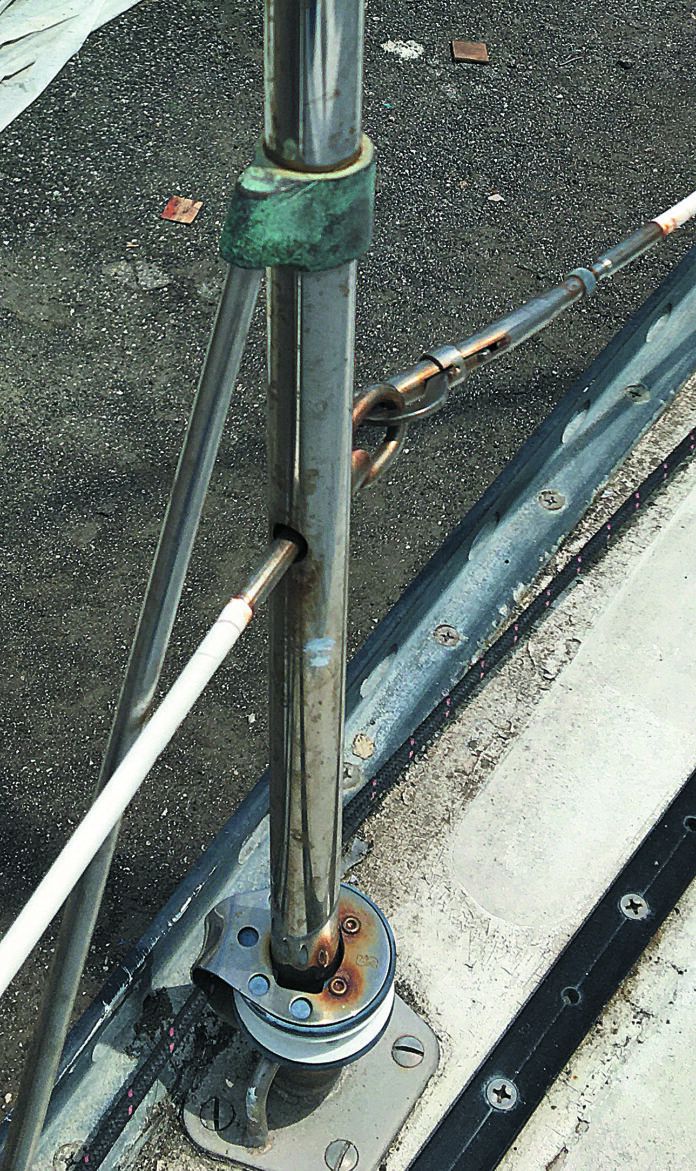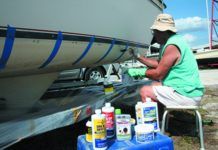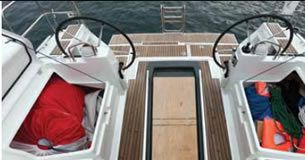This month’s article on Dyneema lifelines sent us diving into the archives for advice on our own little lifeline project. We didn’t have to dig too deep to realize we had more than a simple lifeline replacement on our hands.
BRONZE SUPPORT BRACKET
The green patina on the cast silicone bronze stanchion bracket is a mark of beauty for those who value durability. If we were asked to keep only one piece of stanchion hardware, this would be it (see PS October 2017, “Essential Sailing Gear that Lasts”).
We don’t intend to polish it, but if we did, PS has several metal polish reports, including a report on bronze polishes (see PS January 2007, “Bronze Polish Test”).
SWAGED END FITTINGS
Machine swaged end fittings of Type 304 steel, instead of the superior, more corrosion-resistant T316 steel, are common. If a lifeline fails due to corrosion, the threaded terminal fittings—to a locking gate hook, in this case — are weak points that often bend or break first.
If these studs are bent or corroded, chances are they are existing on borrowed time, and to use them with replacement wire would be counterproductive .
With red rust stains bleeding through the lifeline cover in all segments of the lifeline, a quick visual inspection left no question that the lifeline must be replaced. Stripping back the plastic cover revealed more rust and even some broken strands in the middle sections.
Preferring the devil we know to the one we can’t see, the replacement will be bare 1 x 19 stainless steel wire of 3/16 inch, as specified by the Offshore Racing Council for boats of more than 43 feet (see PS August 2002, “Offshore Log: Check Your Lifelines, Save Your Life”).
UV DAMAGED SHEAVE
Brittle white plastic sheaves succumb to UV sooner than the newer glass-reinforced sheaves. Our plan for this furling lead is to shop around (see PS October 2015, “Refining Furling Line Fairleads”) or maybe fashion a replacement using home made textile block (see PS August 2021, “Sizing-up Improvements in Low Friction Rings.”)
If the block was a conventional block we’d replace the sheave with a better one and replace the axle at the same time with a Grade 316 stainless steel bolt of matching diameter (see PS September 2000, “Rebuilding Old Blocks”).
CRACKED SEALANT
Eventually all the deck hardware, including the stanchions, will be rebonded, and checked for proper backing (see PS August 2016, “How-Big Does A Backing Plate Need To Be?”) As far as sealant goes, we’ll probably go with Sikaflex LOT 291 for the stanchions, as recommended in our report on adhesive sealants (see PS August 2010, “The Great Stickup: Practical Sailor Tests Marine Adhesives, Caulks, and Sealants”). Our more recent follow-up test also highlighted a Sika product along with others (see PS December 2016, “Marine Sealant Adhesion Test).










































